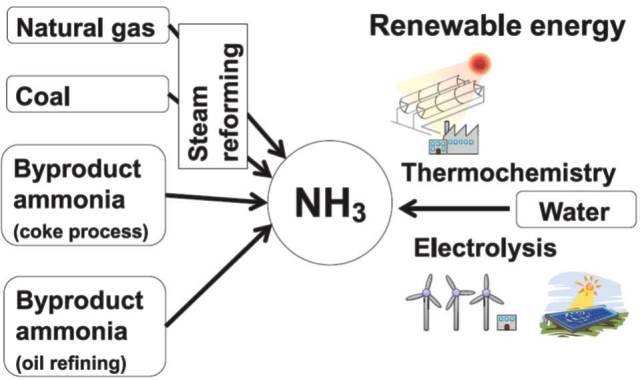3 0 0 0 OA アンモニアによる水素貯蔵と運搬
- 著者
- 小島 由継
- 出版者
- 公益社団法人 日本表面科学会
- 雑誌
- 表面科学 (ISSN:03885321)
- 巻号頁・発行日
- vol.36, no.11, pp.583-588, 2015-11-10 (Released:2015-12-01)
- 参考文献数
- 46
- 被引用文献数
- 1 3
Hydrogen can be stored in many different forms as compressed or liquefied hydrogen in tanks, as a hydrogen-absorbing alloy, as metal hydrides with light elements, as organic hydrides or by adsorption on carbon materials. Ammonia has been expected as a hydrogen energy carrier because it has a high H2 storage capacity with 17.8 wt% and 10.7-12.1 kgH2/100 L. The volumetric hydrogen density is 1.5-2.5 times of liquid hydrogen, and it is easily liquefied under about 1 MPa at room temperature. Ammonia has advantages in cost and convenience as a hydrogen carrier for fuel cell vehicles, energy carrier for solid oxide fuel cell (SOFC), gas turbine of electric power plants. Current PEM fuel cells are poisoned by trace levels (> 0.1 ppm) of ammonia. After hydrogen generation by ammonia cracking, ammonia absorption materials will be useful to produce the high purity hydrogen gas.
2 0 0 0 OA 炭素系物質の化学的水素貯蔵
- 著者
- 宮岡 裕樹 市川 貴之 小島 由継
- 出版者
- 公益社団法人 日本金属学会
- 雑誌
- 日本金属学会誌 (ISSN:00214876)
- 巻号頁・発行日
- vol.77, no.12, pp.552-558, 2013 (Released:2013-12-01)
- 参考文献数
- 26
Hydrogen is chemically absorbed into graphite by mechanical ball-milling process under H2, and its hydrogen capacity reaches to about 3.6 mass%. Noteworthy, when iron (Fe) mingles with graphite from steel balls during the milling process, the hydrogen capacity is drastically enhanced. In this work, the hydrogen absorption and desorption properties of the hydrogenated graphite with and without Fe were investigated. The hydrogen capacity of graphite including Fe was about 6 mass% (H/C), suggesting that the excess hydrogen of 2.4 mass% would originate in the Fe related phase. It is clarified by spectroscopic studies that the mingled iron formed a non-stoichiometric iron-carbon (Fe-C) phase as hydrogen absorption site. Assuming that the Fe/C ratio is 1, its hydrogen capacity is estimated to be H/(Fe-C-H)>10 mass%, which is a larger value than that of the conventional hydrogen storage materials. The hydrogen absorbed in the C-Fe phase is released at 450℃ with the transformation of the C-Fe phase to well-ordered carbides such as Fe3C. Therefore, if the C-Fe phase could be synthesized independently, it should be recognized as a promising hydrogen storage material.
